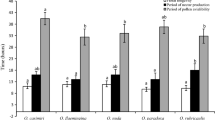Abstract
Pollination of the alpine herbDianthus glacialis was studied in a population in the Swiss Alps in 1991 and 1992. Only one insect species,Zygaena exulans (Lepidoptera), was observed to visit the flowers ofD. glacialis. Pollen loads onZ. exulans indicate that it is an effective pollinator ofD. glacialis. In 1991,Z. exulans frequently visited flowers ofD. glacialis. However, in 1992 almost no visits could be observed. Despite the occurrence of pollinators and the conspicuous flowers ofD. glacialis, there are strong indications that this plant is mainly selfing: (1) anthesis of individual flowers is short (c. one and a half days), (2) protandry, although pronounced in otherDianthus spp., is absent, (3) nectar production is low, (4) odour production is weak, (5) seed production by spontaneous selfing is high, (6) seed set in emasculated flowers is extremely low and (7) the seed/ovule ratio is distinctly higher inD. glacialis than in outcrossing plants.—Selfing inD. glacialis could have evolved under a shortage of pollinators during the glaciation periods. Present levels of cross-pollination byZ. exulans have apparently not been sufficient to reverse the pollination mechanism ofD. glacialis from selfing to outcrossing.
Similar content being viewed by others
References
Baker, H. G., Baker, I., 1977: Intraspecific constancy of floral nectar amino acid complements. — Bot. Gaz.138: 183–191.
—, —, 1980: Studies of nectar-constitution and pollinator-plant coevolution. — InGilbert, L. E., Raven, P. H., (Eds): Coevolution of animals and plants, 2nd edn, pp. 100–140. — Austin, London: Texas University Press.
—, —, 1982: Chemical constituents of nectar in relation to pollination mechanisms and phylogeny. — InNitecki, M., (Ed.): Biochemical aspects of evolutionary biology, pp. 131–171. — Chicago: University of Chicago Press.
—, —, 1983: Floral nectar sugar constituents in relation to pollinator type. — InJones, C. E., Little, R. J., (Eds): Handbook of experimental pollination biology, pp. 117–141. — New York, Cincinnati, Toronto, London, Melbourne: Scientific and Academic Editions, van Nostrand Reinhold Company.
—, —, 1986: The occurrence and significance of amino acids in floral nectar. — Pl. Syst. Evol.151: 175–186.
Baker, I., 1979: Methods for the determination of volumes and sugar concentrations from nectar spots on paper. — Phytochem. Bull.12: 40–42.
Erhardt, A., 1988: Pollination and reproduction inDianthus silvester Wulf. — InCresti, M., Cori, P., Pacini E., (Eds): Sexual reproduction in higher plants, pp. 351–356. — Berlin, Heidelberg, New York, Tokyo: Springer.
—, 1990: Pollination ofDianthus gratianopolitanus (Caryophyllaceae). — Pl. Syst. Evol.170: 125–132.
—, 1991: Pollination ofDianthus superbus L.. — Flora185: 99–106.
—, 1993: Pollination of the edelweiss,Leontopodium alpinum. — Bot. J. Linn. Soc.111: 229–240.
Grant, V., Grant, K. A., 1965: Flower pollination in the phlox family. — New York: Columbia University Press.
Grob, K., 1973: Organic substances in potable water and in its precursor. Part I, Methods for their determination by gas liquid chromatography. — J. Chromatogr.84: 255–273.
—, 1976: Stripping of trace organic substances from water. Equipment and procedure. — J. Chromatogr.117: 285–294.
Hess, H. E., Landolt, E., Hirzel, R., 1967: Flora der Schweiz und angrenzender Gebiete,I. — Basel, Stuttgart: Birkhäuser.
Kaiser, R., 1993: Vom Duft der Orchideen. — Basel: Roche.
Knudsen, J., Tollsten, L., Bergström, G., 1993: Floral scents—a checklist of volatile compounds isolated by head-space techniques. — Phytochemistry33: 253–280.
Knuth, P., 1898: Handbuch der Blütenbiologie,II 1. — Leipzig: Engelmann.
Loew, E., 1894: Blütenbiologische Florisk des mittleren und nördlichen Europa sowie Grönlands. — Stuttgart: Enke.
Martens, D. A., Frankenberger Jr., W. T., 1990: Determination of saccharides by high performance anion-exchange chromatography with pulsed amperometric detection. — Chromatographia29: 7–10.
Meusel, H., Mühlberg, H., 1979: UnterfamilieSilenoideae (Lindl.)A. Br. — InRechinger, K. H., (Ed.):Gustav Hegi, Illustrierte Flora von Mitteleuropa3/2, 2nd edn, pp. 947–1182. — Berlin: Parey.
Müller, H., 1881: Alpenblumen, ihre Befruchtung durch Insekten und ihre Anpassungen an dieselben. — Leipzig: Engelmann.
Richards, A. J., 1986: Plant breeding systems. — London: George Allen & Unwin.
SAS 1989: JMP User's guide. — Cary, NC, USA: SAS Institute Inc.
— 1992: Technical report P-229. — Cary, NC, USA: SAS Institute Inc.
Schroeter, C., 1926: Das Pflanzenleben der Alpen, 2. Aufl. — Zürich: Albert Ramstein.
Vogel, S., 1954: Blütenbiologische Typen als Elemente der Sippengliederung. — Bot. Stud.1: 1–338. — Jena: Fischer.
Wiens, D., 1984: Ovule survivorship, brood size, life history, breeding systems, and reproductive success in plants. — Oecologia64: 47–53.
—, 1987: Reproductive success, spontaneous embryo abortion, and genetic load in flowering plants. — Oecologia71: 501–509.
Wyatt, R., 1983: Pollinator-plant interactions and the evolution of breeding systems. — InReal, L., (Ed.): Pollination biology, pp. 51–95. — London, New York: Academic Press.
—, 1988: Phylogenetic aspects of the evolution of self-pollination. — InGottlieb, L. D., Jain, S. K., (Eds): Plant evolutionary biology, pp. 109–131. — London, New York: Chapman & Hall.
Author information
Authors and Affiliations
Rights and permissions
About this article
Cite this article
Erhardt, A., Jäggi, B. From pollination byLepidoptera to selfing: The case ofDianthus glacialis (Caryophyllaceae). Pl Syst Evol 195, 67–76 (1995). https://doi.org/10.1007/BF00982316
Received:
Revised:
Accepted:
Issue Date:
DOI: https://doi.org/10.1007/BF00982316




